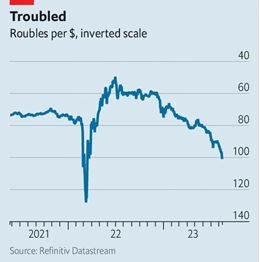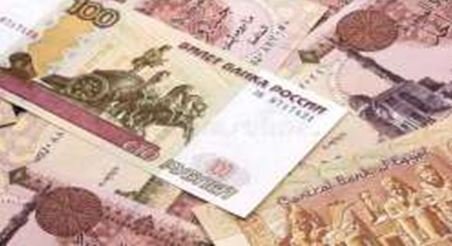The rouble’s recent struggles, coupled with the Russia-Ukraine conflict, present ongoing challenges. China’s prominence as Russia’s key trade partner highlights the role of international ties in Russia’s economy, while the Bangladesh-Russia trade remains stable and mutually beneficial
In a move to address ongoing economic challenges and reduce pressure on the rouble stemming from capital outflows, Russia has recently approved a shortened list of countries whose banks can trade on its foreign exchange and derivatives markets. According to information provided by the Russian Embassy in Dhaka on Saturday(23 September 2023), Bangladesh is one of the nations on this list.
This decision, aimed at enhancing the efficiency of currency conversion and facilitating settlements in the national currency, comes amid efforts by Russian authorities to bolster the rouble’s stability in the wake of geopolitical tensions and economic sanctions.
It’s essential to recognize that Russia’s decision is not solely driven by economic factors. Geopolitical considerations are also in play. The country seeks to exert more control over its financial infrastructure, reducing its dependence on external institutions and Western financial markets. Western sanctions against Russia have played a significant role in these developments. The country aims to shield itself from the potential disruption caused by these sanctions.
Rouble’s Recent Struggles
On August 14th, the Russian rouble experienced a sharp decline, surpassing 100 roubles against the US dollar, marking it as one of the weakest-performing currencies of the year. Consequently, the Bank of Russia convened an emergency meeting in anticipation of a potential increase in interest rates.
The drop in the rouble’s value can be attributed not primarily to international investors but instead to the impact of sanctions and capital controls, which have effectively isolated Russia from the global financial system. Since the G7 imposed a $60 price cap on Russian oil, Russia’s export earnings have declined, while imports, particularly for the war effort, have surged. This has resulted in a significant reduction in Russia’s current account surplus.
While the devalued rouble benefits local oil revenues, it simultaneously drives up the cost of imports. Previously, a strong rouble was considered evidence of the ineffectiveness of Western sanctions. However, the prevailing sentiment in Russia has now shifted to one of concern.
The Bank of Russia faces limited options, especially since approximately $300 billion of its foreign-currency reserves have been frozen by Western nations.
The government is now confronted with a critical decision, either reduce military spending to curtail imports or allow the civilian economy to suffer, potentially leading to inflation and diminished purchasing power for its citizens. The trajectory of Russia’s economy will depend largely on the strategic decisions made by President Putin.

Capital Outflows and Currency Controls
Russian authorities have been grappling with capital outflows, which have contributed to the rouble’s woes. To address this issue, there are discussions about reintroducing currency control measures to protect and stabilize the national currency.
Challenges with Promoting the Rouble
Deputy Finance Minister Alexei Moiseev acknowledged the challenges Russia faces due to its policy of promoting the use of the rouble in international settlements. This approach, while aimed at bolstering the national currency, has also made Russia somewhat vulnerable to fluctuations in its exchange rate.
Expanding Financial Access for “Friendly” Countries
Because of the Russia-Ukraine war from February 2022 to now, the country has been actively working to expand access to its financial infrastructure for “friendly” nations. This effort comes as Russia has faced restrictions in Western financial systems and currencies due to sanctions.
On the other side, Russia categorizes countries that have imposed sanctions against it in response to its actions in Ukraine as “unfriendly.” These sanctions have limited Russia’s access to global financial markets and have been a significant factor in its economic challenges.
Approved List of Friendly Countries
The approved list now includes more than 30 countries, including;
- Armenia
- Azerbaijan
- Belarus
- Kazakhstan
- Kyrgyzstan
- Tajikistan
- Turkmenistan
- Uzbekistan
- Algeria
- Bahrain
- Bangladesh
- Brazil
- China
- Cuba
- Egypt
- India
- Indonesia
- Iran
- Qatar
- Malaysia
- Mongolia
- Morocco
- Oman
- Pakistan
- Qatar
- Saudi Arabia
- Serbia
- South Africa
- Thailand
- Turkey
- United Arab Emirates
- Venezuela
- Vietnam
Exclusions
Notably, some countries that were initially on the draft list published in the summer have been removed. These include;
- Argentina,
- Hong Kong,
- Israel,
- Mexico,
- Moldova.
Moscow Exchange’s Announcement and Government’s Statement
Russia’s largest bourse, the Moscow Exchange, announced that it would broaden FX transaction opportunities starting from September 25. Among the changes, transactions for the dirham-rouble currency pair will be introduced, with settlements conducted in roubles.
The Russian government explained the decision as a means to “improve the efficiency of the mechanism of direct conversion of national currencies of friendly and neutral countries, and forming direct quotations to the rouble to meet the Russian economy’s demand for settlements in the national currency.”

Russia’s Top Trading Partner at presen
As per China’s General Administration of Customs, trade between Russia and China for the initial five months of 2023 stood at $93.8 billion, marking a 41 percent surge compared to the corresponding period in 2022 and an 85 percent rise compared to the first five months of 2021. This data underscores China’s crucial role in supporting the Russian economy and Moscow’s war endeavors.
Russia’s trade surplus with China amounts to $8 billion, with Russia’s exports to China constituting 54 percent ($50.9 billion) of the total trade. The majority of these exports are comprised of Russian mineral fuels and oil, and in May, Chinese imports of Russian crude oil reached an all-time high. Chinese private refineries have been quick to acquire discounted Russian oil, much like their acquisition of Iranian oil in defiance of U.S. sanctions, with Tehran exporting nearly a million barrels per day to China.
For the initial four months of 2023, China’s exports to Russia reached $33.7 billion, reflecting a 66 percent increase compared to the same period in 2022 and an 85 percent rise compared to the same period in 2021. In contrast to Russia’s export profile, China’s exports to Russia encompass a more diverse range of goods that are evenly distributed across key categories. While Russia primarily exports raw materials to China, China’s exports to Russia are primarily comprised of manufactured, processed, and industrial products.
Bangladesh- Russia Trade Relation
Bangladesh and Russia have maintained a cordial trade relationship over the years, with a focus on energy, textiles, and pharmaceuticals. In recent times, this relationship has been characterized by a steady growth in bilateral trade volumes, reflecting the mutual benefits of their economic cooperation.
Energy plays a pivotal role in this partnership, with Russia supplying Bangladesh with oil and natural gas. Bangladesh imports a significant portion of its energy needs from Russia, contributing to its energy security. On the other hand, Bangladesh exports pharmaceutical products, textiles, and ready-made garments to Russia, showcasing its diversified export portfolio.
Statistics indicate that in 2020, the total trade volume between the two countries reached approximately $1 billion. Bangladesh’s exports to Russia were primarily textiles and apparel, while Russia supplied energy resources and machinery in return. It’s essential to note that this trade relationship has been relatively modest compared to Bangladesh’s trade with some other countries.
In conclusion
Russia’s decision to approve a shortened list of countries for forex trading reflects a multifaceted strategy aimed at addressing economic challenges, reducing reliance on external financial systems, and mitigating the impact of Western sanctions. This move, which includes Bangladesh among the approved nations, signifies Russia’s determination to protect its national currency and financial stability. However, the rouble’s recent struggles and the ongoing Russia-Ukraine conflict continue to pose significant challenges. China’s growing role as Russia’s top trading partner underscores the importance of international relationships in shaping Russia’s economic landscape, while the Bangladesh-Russia trade relationship remains steady and mutually beneficial. These developments highlight the complex interplay of economic and geopolitical factors in Russia’s financial decisions and its pursuit of stability amid a challenging global landscape.


